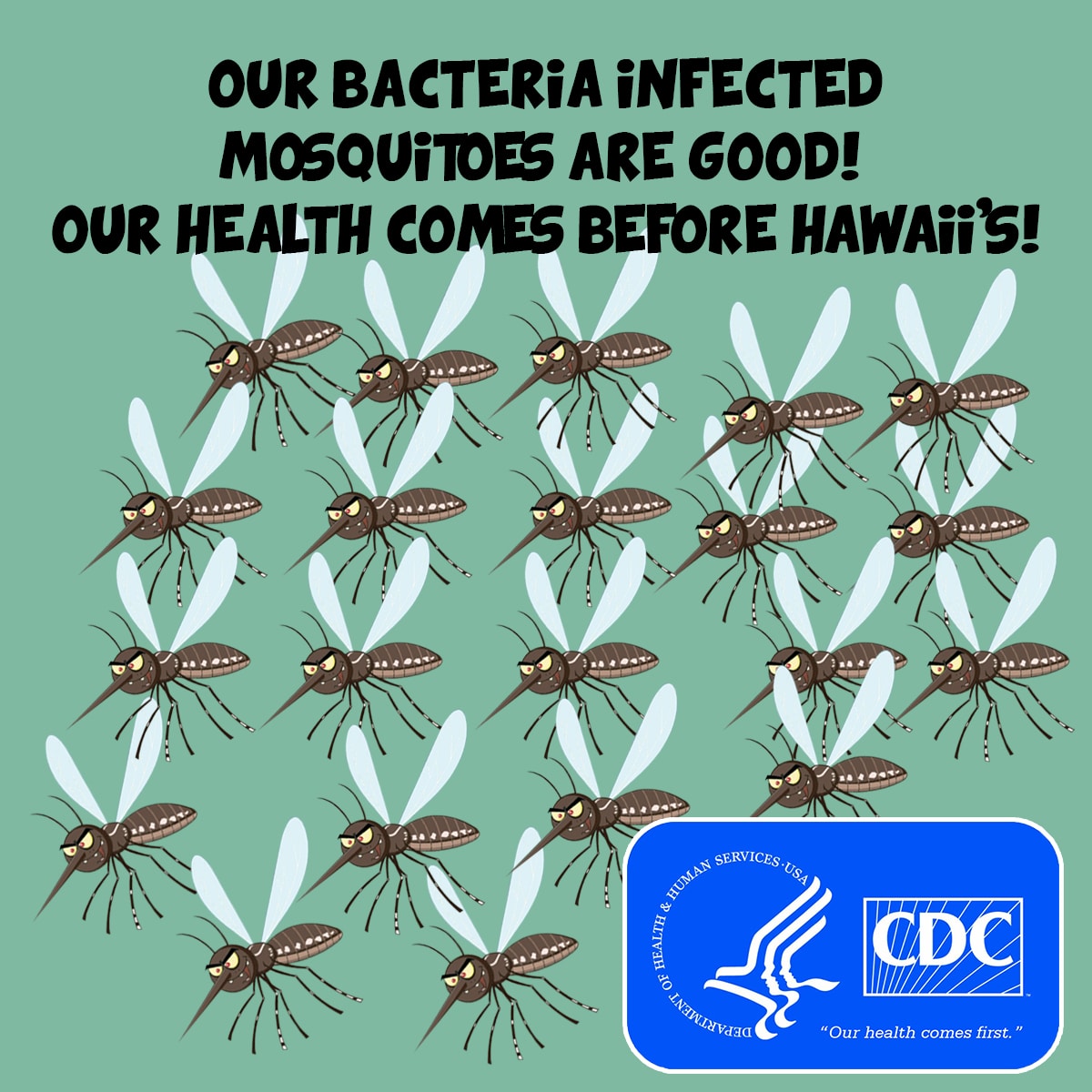
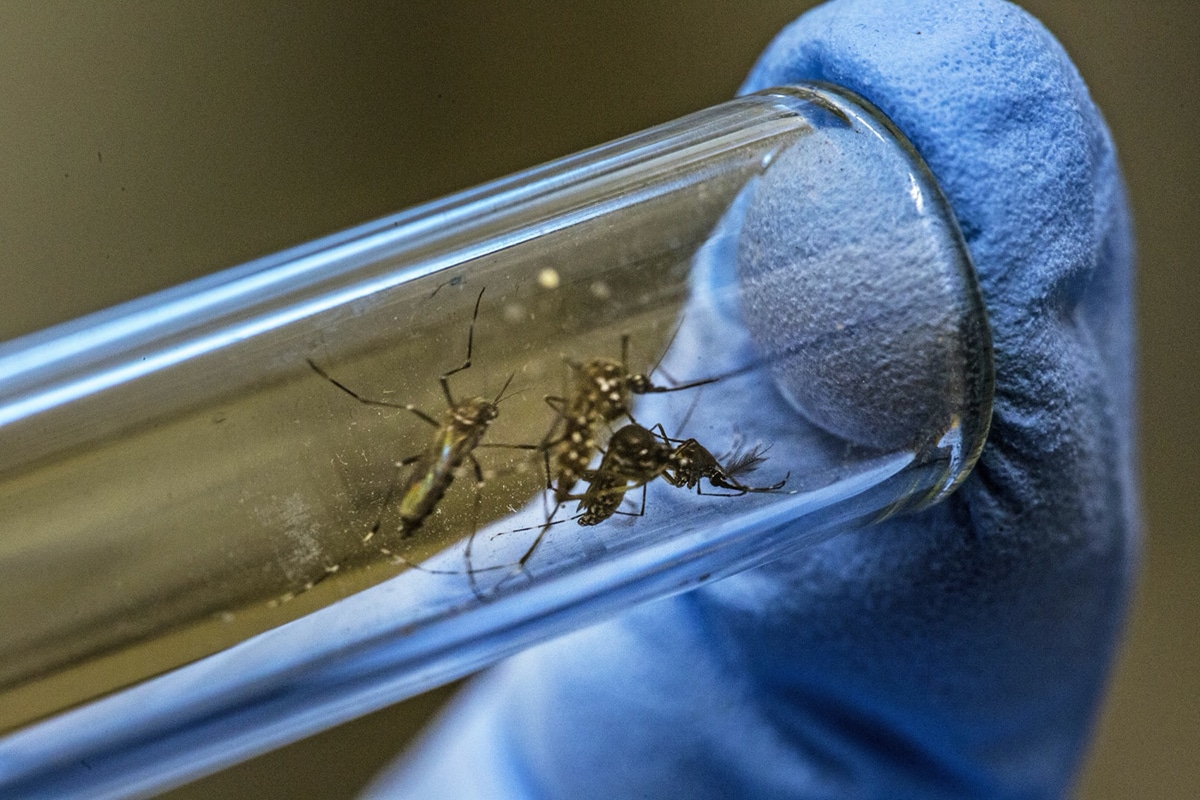
Lab-Altered Mosquito Methods: An Overview
Millions of Wolbachia-bacteria-infected mosquitoes are being released on Maui in a project that is using an experimental form of what is known as the “Incompatible Insect Technique” (IIT). This multi-agency plan is already expanding to the island of Kaua‘i, and long-term goals disclosed in the agencies’ own documents reveal a highly alarming agenda for the Hawaiian Islands. The State is setting the stage for a planned escalation of biotech experiments that put the health of our islands’ people and wildlife at risk and may irreversibly damage our fragile ecosystems.
Mass-production of lab-altered mosquitoes in the Department of Land and Natural Resources’ insectary in Hawai‘i is a goal for the State, and the intention is to produce and release a variety of biotech mosquitoes throughout the islands “into perpetuity” (forever). With millions of dollars in funding continuing to pour in for these mosquito experiments, the agencies involved are moving quickly to advance their timeline and expand their reach.
As we continue to challenge this desecration of our natural environment, it’s important to understand the different methods used to alter mosquitoes in the lab for release globally. Let’s take a look at the types of lab-altered mosquitoes deployed worldwide, compare some of the risks and drawbacks, and debunk misinformation presented by agencies promoting the Hawai‘i plan.
World Mosquito Program Wolbachia Method
The multi-agency partnership Birds, Not Mosquitoes (BNM) responsible for the Wolbachia-bacteria-infected mosquito release projects on Maui and Kaua‘i has presented a slick propaganda campaign touting the use of Wolbachia mosquitoes throughout the world. They reference the population replacement method used by the World Mosquito Program (WMP), even though this WMP “Wolbachia Method” is entirely different from the Wolbachia IIT method currently being implemented here in Hawai‘i.
The main difference is that the WMP Wolbachia Method intentionally releases both male and female mosquitoes weekly for 12-30 weeks to facilitate the establishment of the lab-strain-infected mosquitoes in the environment. The goal is to replace the population of wild mosquitoes with the lab-strain mosquitoes. The reasoning is that the strain of Wolbachia used to infect the targeted species of mosquitoes (in this case, Aedes aegypti) has been shown to make the mosquitoes less capable of transmitting diseases. According to WMP, these diseases include dengue, Zika, chikungunya and yellow fever.
Risks of this method include the intentional release of biting female mosquitoes and the potential for an increase in the number of mosquitoes in release areas.
While the Wolbachia Method is not being used yet in Hawai‘i, it is potentially planned for use. The Hawai‘i Department of Health is running a parallel program where they intend to release lab-altered mosquitoes throughout the islands to “control mosquitoes of public health concern.” Approvals are already in place to use the ground release approach of unleashing mosquitoes by cars, trucks, or ATVs. In addition to the southern house mosquitoes already being brought in for the Wolbachia IIT releases happening now, both Aedes aegypti and Aedes albopictus species have also been added to the list of restricted animals to be imported into the islands.
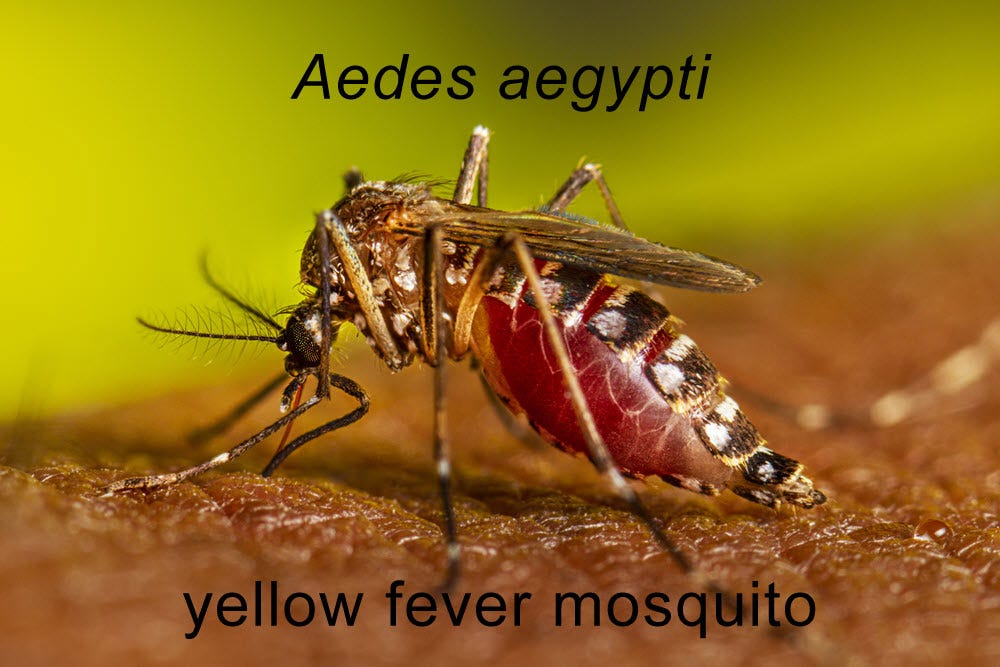
Sterile Insect Technique (SIT)
BNM’s propaganda campaign has continually perpetuated the false assertion that the Wolbachia IIT mosquitoes being released now are sterile. They are not. To be clear, millions of bacteria-infected male mosquitoes are being released that are capable of mating with female mosquitoes infected with the same bacteria strain. This includes the lab-infected females that are being unintentionally released, along with wild females who become infected with the lab strain in the wild through horizontal transmission (the spread of the bacteria directly or indirectly through shared feeding sites, serial predation, or mating).
When BNM references the decades of study using sterile mosquitoes, they’re actually referring to another entirely different method, the Sterile Insect Technique (SIT).
“The sterile insect technique (SIT) is a method of biological insect control whereby overwhelming numbers of sterile insects are released into the wild. The released insects are preferably male, as this is more cost-effective and the females may in some situations cause damage by laying eggs in the crop, or, in the case of mosquitoes, taking blood from humans. The sterile males compete with fertile males to mate with the females. Females that mate with a sterile male produce no offspring, thus reducing the next generation’s population.”
“Sterilization is induced through the effects of x-ray photon irradiation on the reproductive cells of the insects.”
Drawbacks of SIT include cost, reduced male mating fitness and competitiveness, unexpected release of fertile breeding males, difficulty of sex sorting, and accidental release of fertile females. According to WMP, “There is no field evidence that it can reduce the risk of mosquito-borne diseases.”
Incompatible Insect Technique (IIT)
The Incompatible Insect Technique (IIT) is the method being used on Maui and Kaua‘i. The project is being presented as an attempt to suppress southern house mosquitoes that transmit avian malaria to threatened and endangered native honeycreeper birds. For this experiment, the intention is to release male southern house mosquitoes infected in the lab with a strain of Wolbachia bacteria that is supposed to be different from the strain found in wild females here on the islands. The technique is based on cytoplasmic incompatibility caused by the bacteria.
“Cytoplasmic incompatibility (CI) is a mating incompatibility reported in many arthropod species that is caused by intracellular parasites such as Wolbachia. These bacteria reside in the cytoplasm of the host cells (hence the name cytoplasmic incompatibility) and modify their hosts’ sperm in a way that leads to embryo death unless this modification is ‘rescued’ by the same bacteria in the eggs.”
What makes this IIT method different from the WMP Wolbachia Method is that it is being used to suppress the wild mosquito population rather than to replace it. The goal is for the lab-reared males and the wild females to be incompatible when mating so that their offspring are not viable.
The World Mosquito Program describes drawbacks of using Wolbachia IIT:
“This method relies on the continuous production and release of male mosquitoes and is, therefore, more expensive than the World Mosquito Program’s method. There is no field evidence that it can reduce the risk of mosquito-borne diseases.”
WMP’s comparison chart further documents known issues with the Wolbachia IIT method, including the fact that it is not self-sustaining and that very large numbers of mosquitoes need to be continually released over an indefinite period of time or the population will rebound. What the WMP chart doesn’t mention is the issue of accidental release of compatible lab-infected females, nor does it note the ability of wild females to become compatible by being infected with the lab-strain bacteria in the wild through horizontal transmission.
The Wolbachia IIT method being used on Maui and Kaua‘i is experimental. Southern house mosquitoes have never been documented as used before for Wolbachia IIT stand-alone field release anywhere in the world. The East Maui project area is the largest Wolbachia mosquito release of any kind globally to date, and the Kaua‘i project area is the second largest. Additionally, the U.S. Department of the Interior confirms that “Wolbachia IIT is a novel tool for conservation purposes and its degree of efficacy in remote forest landscapes is unknown.”
Peer-reviewed studies show that Wolbachia bacteria can cause increased pathogen infection in mosquitoes and increased disease-transmitting capability. No studies have been done by BNM to assess whether the southern house mosquitoes infected in the lab with the specific strain of bacteria used could cause them to become more capable of spreading diseases to people or animals.
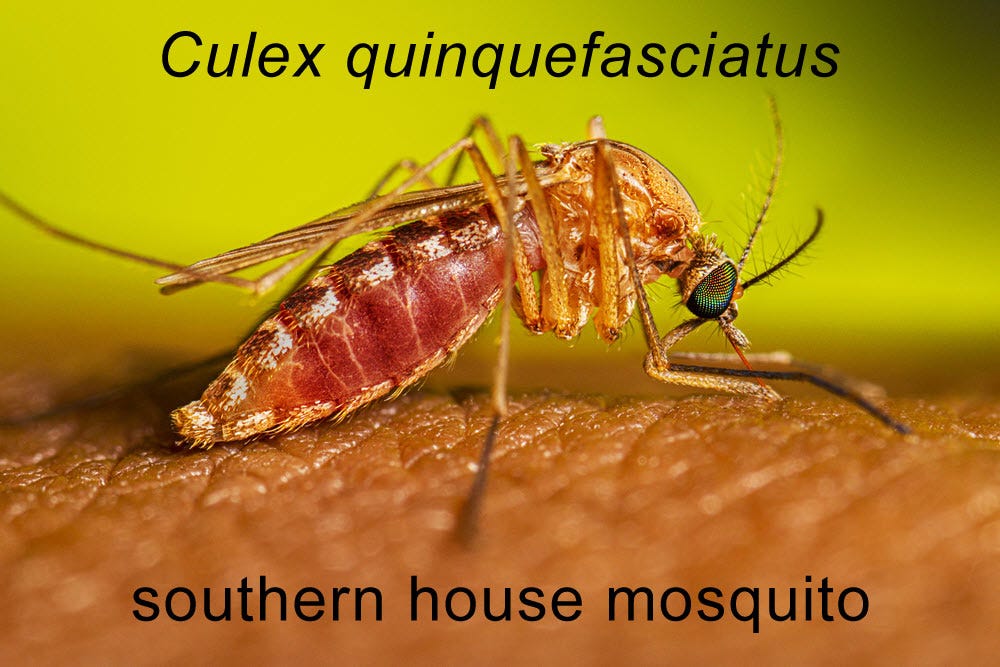
Combined Sterile Insect Technique and Incompatible Insect Technique
The combination of IIT with SIT is described by the World Mosquito Program as another method that is more expensive and has no field evidence of reducing the risk of mosquito-borne diseases. The reason the two methods are used together is explained by WMP:
“IIT requires completely accurate sexing to be effective, otherwise the target population will not decline. Completely accurate sexing can be hard to achieve and so it is possible to combine IIT with low doses of irradiation to sterilize any fertile females that are accidentally released in an IIT program.”
Birds, Not Mosquitoes decided not to use SIT irradiation in combination with IIT, though this approach could have reduced the risks of unintended successful breeding of the fertile Wolbachia-bacteria-infected IIT lab males and any fertile lab females accidentally released due to imperfect sex sorting (“sexing”). Cost may have been a factor, along with concerns about fitness and competitiveness of irradiated males.
Genetic Modification (GMO)
Genetic modification is a suppression technique using a number of different methods that introduce lethal genes into the target mosquito population. WMP acknowledges drawbacks to releasing GMO mosquitoes:
“This method is not self-sustaining and is very expensive, so it’s not often accessible for many communities. Also, as no impact assessment has been done, it hasn’t been proven to be safe for humans.”
Oddly, WMP’s comparison chart contradicts this statement by listing GMO mosquitoes as “Safe for human health.” No explanation is given for this conflicting information.
The leading developer of GMO mosquitoes is Oxitec. Their GMO mosquitoes are called “Friendly™” technology. Oxitec describes their platform as a targeted biological solution:
“Friendly males carry a self-limiting gene that when passed on, prevents their offspring from surviving to adulthood. With regular releases of Friendly males, the number of offspring – in most versions of the technology, specifically the damaging female offspring – is reduced, resulting in a reduction in the pest insect population. Friendly males, and offspring carrying the self-limiting gene, can be tracked through the linked fluorescent marker gene.”
They go on to explain that this method can be applied to all kinds of pests, not just mosquitoes that transmit diseases like dengue and Zika:
“Oxitec is now developing a Friendly™ tick, and the technology has the potential to be applied to animals beyond arthropods.”
Oxitec’s Friendly mosquitoes are genetically engineered to have a self-limiting gene called tTAV:
“When our Friendly™ males are released and reproduce with pest females, their offspring inherit a copy of the self-limiting gene. This gene disrupts the proper functioning of the insects’ cells by over-producing a protein, interfering with the cells’ ability to produce other essential proteins needed for development. This disrupts the insect’s normal development and ability to survive to adulthood.”
“This gene can be adjusted to function only in females, to enable large-scale and simple production of Friendly males only, and to target the pest female, which is frequently the most damaging.
This self-limiting gene can be turned off with an antidote called tetracycline; allowing us to breed our Friendly™ males and females at a large scale without the need for any additional genetic engineering.”
Friendly mosquitoes are also engineered with a marker gene that produces a fluorescent protein called DsRed2 that glows under a special light, is inherited by all offspring, and allows for identification and tracking.
In 2019, a peer-reviewed study highlighted unanticipated outcomes from the release of Oxitec’s first-generation GMO Friendly mosquitoes (OX513A) in a 2013-2015 field trial in Brazil. One concern raised in the study is the introduction of background genetics leading to “hybrid vigor” (the enhancement of offspring’s traits due to mixing of genetic contributions of its parents). Hybridization could result in a more robust population than the pre-release population. The transfer of genetic information could “introduce other relevant genes such as for insecticide resistance.”
Along with concerns about the creation of hybrid “super mosquitoes,” opponents of GMO mosquito releases in Florida raised the alarm about the use of tetracycline potentially causing antibiotic resistance to spread.
BNM decided not to use GMO mosquitoes for the releases on Maui and Kaua‘i, but only because the “technology is not currently available” for use with the targeted species of southern house mosquitoes. In dismissing the GMO option, they noted that “There may also be considerable public resistance to this method as has been seen in Florida.”
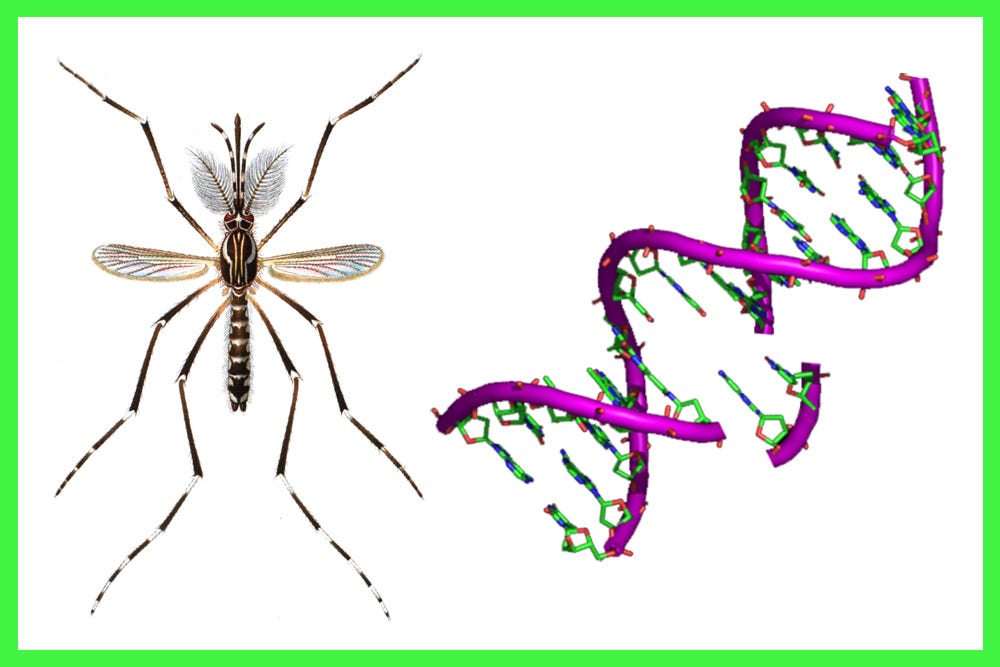
Next Generation Tools
BNM is openly anticipating a need to advance their agenda beyond the experimental Wolbachia IIT approach to mosquito suppression. Agency partners are strategizing the development of “more effective tools,” including gene drives and CRISPR gene-edited precision-guided Sterile Insect Technique (pgSIT) mosquitoes. Their objective for deployment of these “next-generation tools” involves pre-implementation plans to improve genetics and animal care facilities for the U.S. Department of the Interior in Hawai‘i to allow for in-vitro and in-vivo tool trials starting this year. Research and development for synthetic biology control tools and IIT advances are already in the works.
Precision-Guided Sterile Insect Technique (pgSIT)
The Akbari Laboratory at the University of California San Diego is being funded to explore the development of next generation precision-guided Sterile Insect Technique (pgSIT) mosquito control tools. This pgSIT technology is currently being developed in southern house mosquitoes, and the plan is to mass-produce them in Hawai‘i’s Department of Land and Natural Resources lab insectary for release on the islands.
PgSIT uses CRISPR technology to selectively modify DNA, generating sterile males and flightless females that can be deployed at any life stage. This approach is different from gene drive systems in that it is meant to be self-limiting and is not intended to spread or persist in the environment. However, there are serious risks associated with CRISPR, including the potential for unintended “off-target” genome editing effects and mutations.
Gene Drives
Gene drives are described in a 2023 Scientific American article as a new technology that “could wipe out whole species.” The article questions whether gene drives are “a magic bullet or a genetic atom bomb”:
“This technology allows a chosen set of genes to alter an animal’s biology in some way, such as making them produce sterile offspring. The inability to reproduce then sweeps through a population, upending the laws of inheritance. The genes copy themselves exponentially from generation to generation, rapidly coming to dominate the whole population.”
“Following the advent of CRISPR-based gene editing in 2013, this dream became a reality. And in 2015 researchers at the University of California, San Diego, created a lab-based gene drive in the innocuous vinegar flies Drosophila that simply made all the flies’ eyes turn yellow. They said they had built ‘a mutagenic chain reaction.’ In other words, they had made what might be considered a ‘genetic atom bomb.’ If one of these things were released into the wild, there would be no way of stopping it.
Researchers around the world soon developed gene drives in mosquitoes.”
“Gene drive pioneer Kevin Esvelt of the Massachusetts Institute of Technology predicted that, by 2030, there would be a lab leak or some other incident involving gene drives. ‘It’s not going to be bioterror, it’s going to be bioerror,’ he said in 2016.”
“Gene drive opponents, concerned about potential ecological damage and suspicious of DARPA and other funders, have called for a moratorium on research. Research nonetheless continues, but it is generally agreed that environmental risk assessments and the active involvement of affected communities are required before any release might be considered. Because of the potential consequences on their environment, people need to give what is called free, prior, informed consent.
Active efforts are underway to test what might happen if gene drives are allowed into the wild. In 2021 Imperial College London researchers funded by Target Malaria, a not-for-profit research consortium itself funded by the Bill & Melinda Gates Foundation, identified eight major ecological effects of gene drives, which could manifest themselves through 46 pathways. Among the potential problems they explored were the possibility that the gene drive could spread to valued nontarget species, leading a decline in their density or in the health of ecosystem services to which they contribute. There is also the risk that the gene drive could produce unexpected genetic alterations to the target species, such as making it able to tolerate a broader range of environmental conditions, leading to the spread of the disease-spreading insect, instead of its elimination.”
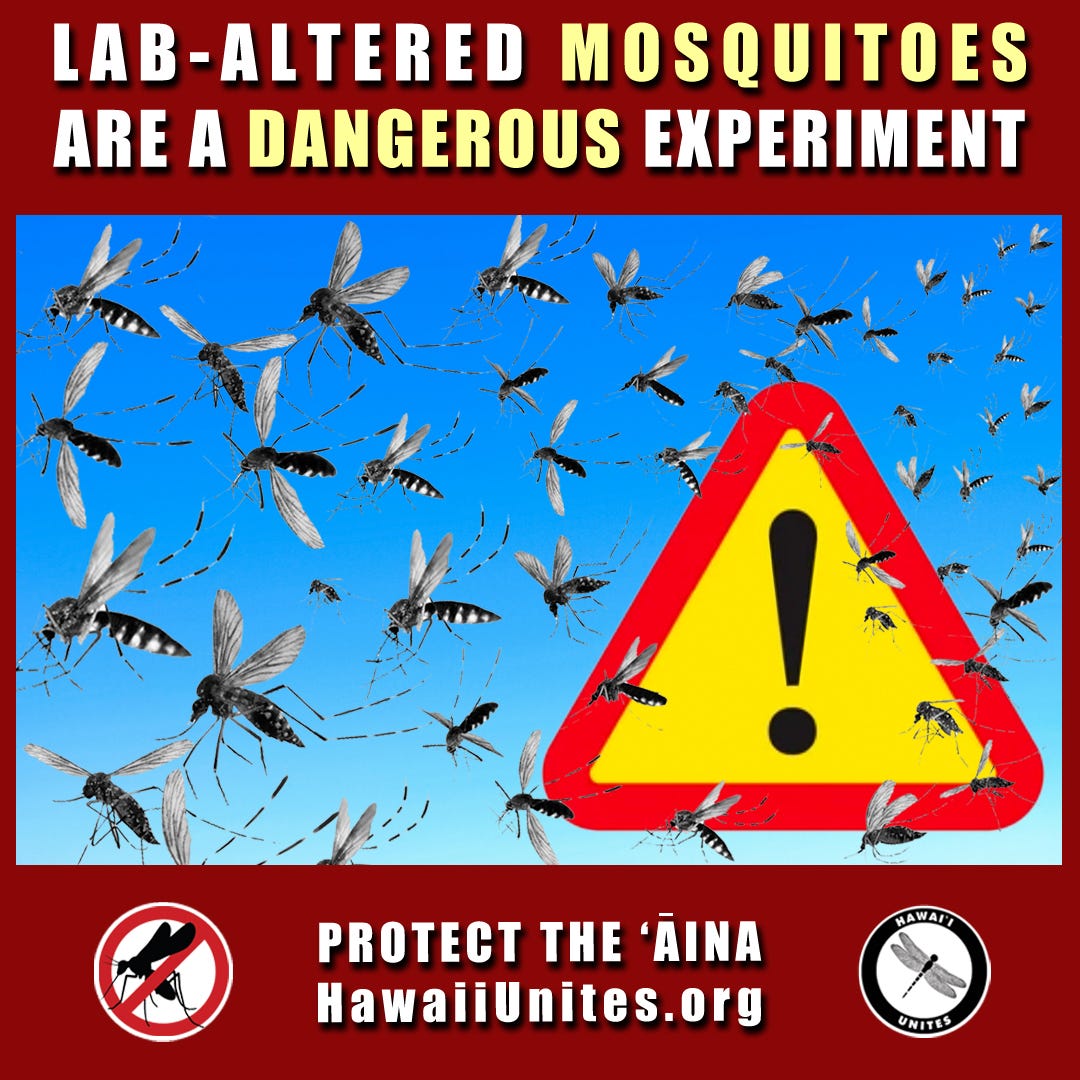
Conclusion
Releasing lab-altered mosquitoes into our environment could cause significant impacts to the balance of nature. All of these mosquito methods can have unexpected outcomes and unintended consequences. Who will be held accountable if something goes wrong? What if there’s an increase in disease transmission to people or animals, or if the suppression of one species of mosquito causes a surge in the population of another mosquito species, or if wild mosquito populations are replaced with mosquitoes that are more capable of spreading disease? The Hawaiian Islands are not a petri dish for biotech industry experimentation.
The Wolbachia IIT bacteria-infected mosquitoes being released now by the multi-agency partnership Birds, Not Mosquitoes are a dangerous experiment. Hawai‘i Unites has taken the Department of Land and Natural Resources and its Board to court to stop these releases. We’re seeking a ruling to require an environmental impact statement and comprehensive studies of the risks of this reckless plan. Our case can set a precedent that strengthens Hawai‘i’s environmental laws and sends a clear message to the biotech industry that these sacred lands are not their testing grounds.
We have an active case that is in the appeals process. This case is strong, and we’re ready to take it to trial. You can help us continue challenging this mosquito release agenda by making a tax-deductible donation to our organization.
Mahalo,
Tina Lia
Founder
Hawai‘i Unites
HawaiiUnites.org
Hawai‘i Unites is a 501(c)(3) nonprofit organization dedicated to the conservation and protection of our environment and natural resources. Your tax-deductible donations help us to fulfill our mission of honoring and protecting our sacred connection to the natural world.



